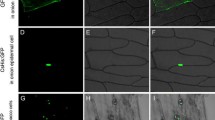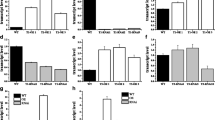Abstract
A drought- and abscisic acid (ABA)-inducible gene, His1, was isolated from Lycopersicon pennellii, a drought-resistant relative of cultivated tomato, and the gene structure was defined experimentally. The nucleotide sequence of His1 predicts a protein of 202 amino acid residues, with a significant sequence homology to plant H1 histones. Consensus sequences for both H1 histone-specific promoter elements as well as an ABA-responsive element were identified in the 5′-flanking region of His1. Transcripts of this gene accumulate in leaf tissue in response to drought in three tomato species including cultivated tomato (L. esculentum), L. pennellii, and L. chilense, as well as in tobacco. Transcripts for His1 are constitutively expressed in roots; transcript abundances in tomato root tips were equivalent to transcript abundances in more mature regions of the seedling root. The accumulation in leaves of transcripts for His1 preceded visible symptoms of drought stress in the plants. Transcript accumulation was detected in both drought-sensitive and drought-resistant species at similar leaf water potentials, 255-1 −1.3 to −1.4 MPa.
Similar content being viewed by others
References
Altschul SF, Warren G, Miller W, Myers EW, Lipman DJ: Basic local alignment search tool. J Mol Biol 215: 403–410 (1990).
Arents G, Burlingame RW, Wang B-C, Love WE, Moudrianakis EN: The nucleosomal core histone octamer at 3.1 Å resolution: a tripartite protein assembly and a left-handed superhelix. Proc Natl Acad Sci USA 88: 10148–10152 (1991).
Ausubel FM, Brent R, Kingston RE, Moore DD, Seidman JG, Smith JA, Struhl K: Current Protocol in Molecular Biology. John Wiley, New York (1989).
Bartholomew DM, Bartley GE, Scolnik PA: Abscisic acid control of rbcS and cab transcription in tomato leaves. Plant Physiol 96: 291–296 (1991).
Benfey PN, Ren L, Chua N-H: Tissue specific expression from CaMV 35S enhancer subdomains in early stages of plant development. EMBL J 9: 1677–1684 (1990).
Brandt WF, von Holt C: Variants of wheat histone H1 with N- and C-terminal extensions. FEBS Letts 194: 282–286 (1986).
Bray EA: Drought- and ABA-induced changes in polypeptide and mRNA accumulation in tomato leaves. Plant Physiol 88: 1210–1214 (1988).
Bray EA: Molecular responses to water deficit. Plant Physiol 103: 1035–1040 (1993).
Chandler PM, Robertson M: Gene expression regulated by abscisic acid and its relation to stress tolerance. Annu Rev Plant Physiol Plant Mol Biol 45: 113–141 (1994).
Chen R-D, Tabaeizadeh Z: Expression and molecular cloning of drought-induced genes in the wild tomato Lycopersicon chilense. Biochem Cell Biol 70: 199–206 (1992).
Clore GM, Gronenborn AM, Nilges M, Sukumaran DK, Zarbock J: The polypeptide fold of the globular domain of histone H5 in solution. A study using nuclear magnetic resonance, distance geometry and strained molecular dynamics. EMBO J 6: 1833–1842 (1987).
Cockerill PN, Garrard WT: Chromosomal loop anchorage of the kappa immunoglobulin gene occurs next to the enhancer in a region containing topoisomerase II sites. Cell 44: 273–282 (1986).
Cohen A, Plant AL, Moses MS, Bray EA: Organ-specific and environmentally regulated expression of two abscisic acid-induced genes of tomato. Plant Physiol 97: 1367–1374 (1991).
Cole RD: A minireview of microheterogeneity in H1 histone and its possible significance. Anal Biochem 136: 24–30 (1984).
Croston G, Kerrigan LA, Lira LM, Marshak DR, Kadonaga JT: Sequence-specific antirepression of histone H1-mediated inhibition of basal RNA polymerase II transcription. Science 251: 643–649 (1991).
Dalton S, Wells JRE: A gene-specific promoter element is required for optimal expression of the histone H1 gene in S-phase. EMBO J 7: 49–56 (1988).
Gantt JS, Key JL: Molecular cloning of a pea H1 histone cDNA. Eur J Biochem 166: 199–125 (1987).
Gantt JS, Lenvik TR: Arabidopsis thaliana H1 histones, analysis of two members of a small gene family. Eur J Biochem 202: 1029–1039 (1991).
Gigot C, Spiker S: Nomenclature of genes encoding histones. Plant Mol Biol Rep 12: S39-S40 (1994).
Glass DB, El-Maghrabi MR, Pilkis SJ: Synthetic peptides corresponding to the site phosphorylated in 6-phosphofructo-2-kinase/fructose-2,6-bisphosphates as substrates of cyclic nucleotide-dependent protein kinases. J Biol Chem 261: 2987–2993 (1986).
Hendrikson FM, Cole RD: Selectivity in the interaction of various DNA sequences with H1 histones. Biochemistry 33: 2997–3006 (1994).
Hentschel CC, Birnstiel M: The organization and expression of histone gene family. Cell 25: 301–303 (1981).
Ho T-Y, Mishkind ML: The influence of water deficits on mRNA levels in tomato. Plant Cell Environ 14: 67–75 (1991).
Jayawardene N, Riggs CD: Molecular cloning, sequence analysis and differential expression of an intron-containing gene encoding tomato histone H1. Eur J Biochem 223: 693–699 (1994).
Kahn TL, Fender SE, Bray EA, O'Connell MA: Characterization of expression of drought- and ABA-regulated tomato genes in the drought resistant species Lycopersicon pennellii. Plant Physiol 103: 597–605 (1993).
Kneller DG, Cohen FE, Langridge R: Improvements in protein secondary structure prediction by an enhanced neural network. J Mol Biol 214: 171–182 (1990).
Laybourn PJ, Kadonaga JT: Role of nucleosomal cores and histone H1 in regulation of transcription by RNA polymerase II. Science 254: 238–245 (1991).
Mirkovitch J, Mirault M-E, Laemmli UK: Organization of the higher-order chromatin loop: specific DNA attachment sites on nuclear scaffold. Cell 39: 223–232 (1984).
Osley MA: The regulation of histone synthesis in the cell cycle. Annu Rev Biochem 60: 827–861 (1991).
Pla M, Vilardell J, Guiltinan MJ, Marcotte WR, Nicogret MF, Quatrano RS, Pages M: The cis-regulatory element CCACGTGG is involved in ABA and water-stress responses of the maize gene rab28. Plant Mol Biol 21: 259–266 (1993).
Plant AL, Cohen A, Moses MS, Bray EA: Nucleotide sequence and spatial expression pattern of a drought- and ABA-induced gene of tomato. Plant Physiol 97: 900–906 (1991).
Razafimahatratra P, Chaubet N, Philipps G, Gigot C: Nucleotide sequence and expression of a maize H1 histone cDNA. Nucl Acids Res 19: 1491–1496 (1991).
Rick CM: Potential genetic resources in tomato species: clues from observation in native habitats. In: Srb AM (ed) Genes, Enzymes and Populations, pp. 255–269. Plenum Press, New York (1973).
Roth SY, Allis CD: Chromatin condensation: does histone H1 dephosphorylation play a role? Trends Biochem Sci 17: 93–98 (1992).
Shen Q, Ho T-FD: Functional dissection of an abscisic acid (ABA)-inducible gene reveals two independent ABA-responsive complexes each containing a G-box and a novel cis-acting element. Plant Cell 7: 295–307 (1995).
Skriver K, Mundy J: Gene expression in response to abscisic acid and osmotic stress. Plant Cell 2: 503–512 (1990).
Szekeres M, Haizel T, Adam E, Nagy F: Molecular characterization and expression of a tobacco histone H1 cDNA. Plant Mol Biol 27: 597–605 (1995).
Thompson AJ, Corlett JE: mRNA levels of four tomato (Lycopersicon esculentum Mill. L.) genes related to fluctuating plant and soil water status. Plant Cell Environ 18: 773–780 (1995).
Vellanoweth RL, Okita TW: Analysis of nuclear proteins interacting with a wheat α/β-gliadin seed storage protein gene. Plant Mol Biol 22: 25–41 (1993).
Wolffe AP: New insights into chromatin function in transcriptional control. FASEB 6: 3354–3361 (1992).
Woodgett JR, Gould KL, Hunter T: Substrate specificity of protein kinase C-use of synthetic peptides corresponding to physiological sites as probes for substrate recognition requirements. Eur J Biochem 161: 177–184 (1986).
Yamaguchi-Shinozaki K, Shinozaki K: A novel cis-acting element in an Arabidopsis gene is involved in responsiveness to drought, low-temperature, or high-salt stress. Plant Cell 6: 251–264 (1994).
Zarbock J, Clore GM, Gronenborn AM: Nuclear magnetic resonance study of the globular domain of chicken histone H5: Resonance assignment and secondary structure. Proc Natl Acad Sci USA 83: 7628–7632 (1986).
Author information
Authors and Affiliations
Rights and permissions
About this article
Cite this article
Wei, T., O'Connell, M.A. Structure and characterization of a putative drought-inducible H1 histone gene. Plant Mol Biol 30, 255–268 (1996). https://doi.org/10.1007/BF00020112
Received:
Accepted:
Issue Date:
DOI: https://doi.org/10.1007/BF00020112




